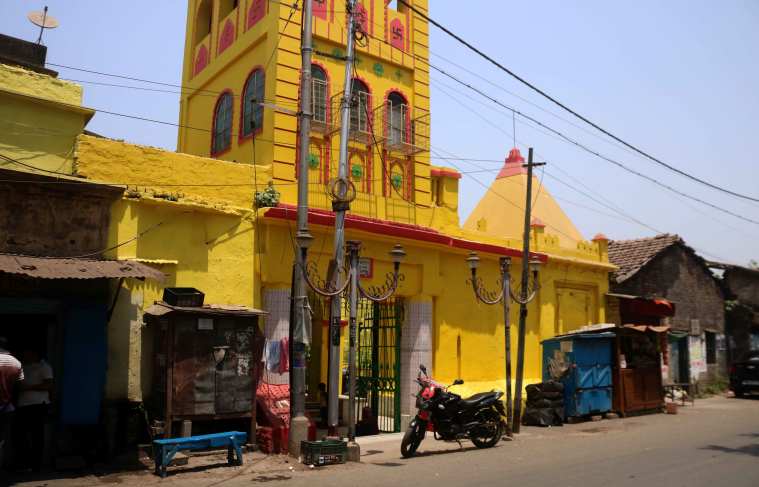Over the years, Chitpur Road has acquired a distinct identity of its own, with the name standing in to represent this north Kolkata neighbourhood itself. It is not clear when Chitpur acquired its name, but historical documentation suggests that it is older than the city of Calcutta itself.
The neighbourhood’s age still reflects in some buildings that remain in the city. One of the oldest roads in the city, “it is said to occupy the site of the old road made by the Sabarna Roy Choudhurys, the old zemindars of Calcutta, from Barisha, where the junior branch resided, to Halisahar, beyond Barrackpore, which was the seat of the senior branch,” writes H.E.A. Cotton in his book ‘Calcutta: Old and New’, of Chitpur Road.
It was also the neighbourhood where Calcutta’s aristocracy set up large residential homes, many of which continue to be preserved as heritage sites under government supervision, while others remain in control of the families themselves.
There are several stories behind how the neighbourhood got its name, but one is this: the road may have gotten its name from the Hindu goddess Chitteshwari in whose honour a temple was built here by Gobindram Mitter, a Bengali aristocrat who was bestowed fortune and favour for working in the interests of the British East India Company. Soon after the British set up their presidency after establishing the city of Calcutta in 1698, Mitter became the second deputy collector of rent to be appointed by the Company.
Mitter’s wealth, power and influence only grew and he quickly rose to become one of the wealthiest zamindars in Bengal, with an extravagant mansion in Chitpur to rival that belonging to the Sabarna Roy Choudhurys and other prominent Bengali zamindars of that time.
This is plate 23 of James Baillie Fraser’s ‘Views of Calcutta and its Environs’. Fraser (1783-1856) arrived in Calcutta in 1814 and in six years produced these animated sketches of the busy city. Moving south into the heart of the city itself, he includes the view of the Black Pagoda in the Chitpore Road, a predominantly native part of Calcutta. This was built in 1731 by Gobindram Mitter, a local zamindar (landlord). It was never completed, and decayed so much that the main tower collapsed around 1813. One of the two subsidiary towers is shown in this image, with the Navaratna, or nine pinnacles. (Photo credit: British Library)
Colonial records indicate that the road was one of the most important pilgrimage routes in ancient Bengal because of the location of the Chitteshwari temple in this neighbourhood. In the 1885 edition of the Imperial Gazetteer of India, William Wilson Hunter, a Scottish historian writes: “…this line (Chitpur Road) was destined to become the central street through the modern city of Calcutta.”
Till the middle of the 19th century, Chitpur Road served to divide the mercantile part of Calcutta dominated by the British, from the “native villages or bastis which clustered inwards to the east” of the Hooghly river. “Practically speaking, the European commerce of Calcutta is concentrated between the river bank on the west and Chipur Road on the east, with Canning Street on the north and Esplanade on the south,” writes Hunter.
 Adi Chitteshwari Durga Temple (Express Photo by Shashi Ghosh)
Adi Chitteshwari Durga Temple (Express Photo by Shashi Ghosh)
There is another story behind how the neighbourhood got its name. While Kumartuli, within the neighbourhood of Chitpur, is a well-known artisans colony, there was another group of artisans who had set up home here—the chitrakar, traditional scroll painters, also known as the patuas. Like the kumars of Kumartuli whose profession of idol-making was reflected in their last names, the patuas of Chitpur also followed similar naming conventions.
In his book ‘Kalighat Painting Images from a Changing World’ (1999), Jyotindra Jain writes that the chitrakars of Kalighat relocated to Chitpur to escape from an increasing number of robbers in that area, thus giving the neighbourhood the community’s name. After the artisans relocated, the new neighbourhood led to a development in the painting styles, resulting in the unique genre of the Chitpur style that followed the Kalighat school.
The large mansions and iconic colonial structures around Chitpur tend to dominate conversations about the neighbourhood, leading many to gloss over how it was where Calcutta’s publishing industry first started in Battala.
In the locality of Battala where the publishing industry was based, Chitpur prints, the genre of printed books known as Chitpur relief prints or Battala chapapat, meaning printed pictures of Battala, developed in this neighbourhood, writes Amitabh SenGupta in his book ‘Scroll Paintings of Bengal: Art in the Village’ (2012). “The pictures were first printed on cheap paper, from handmade wood blocks (also metal blocks) and then hand-tinted with colours”, writes SenGupta.
 Kumartuli (Express Photo by Shashi Ghosh)
Kumartuli (Express Photo by Shashi Ghosh)
It would be remiss to write about Chitpur without mentioning one of the most prominent families who lived there—the Tagores of Jorasanko, whose ancestral home has now been converted into a museum and university. Built in the 18th century, researchers at the Rabindra Bharati University say the house has been preserved to look as it was when Rabindranath Tagore lived there. The interiors of the house have been modified to incorporate a museum archiving the Tagore family’s history and artefacts but it remains one of the most well-preserved examples of tropical colonial Bengali architecture.
Read here more stories of street names in Kolkata
For close to two centuries, Chitpur was not officially a part of the Calcutta metropolitan area despite being a residential neighbourhood for some of Bengal’s wealthiest zamindars and foreigners. Chitpur, along with other neighbouring areas, was considered the peripheries of the city till it was incorporated into the suburban municipality in 1876, writes Sukanta Chaudhuri in his book ‘Calcutta – The Living City: Volume II: The Present and Future’ (2000). In 1931, it was merged into the Calcutta metropolitan area.
Source: https://indianexpress.com/article/research/streetwise-kolkata-chitpur-home-of-the-well-heeled-but-maybe-named-after-a-temple-7286017/


